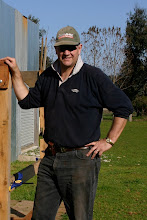So far our fertility program has been basically conventional. We have put a tonne of lime to the acre across the farm twice - and we have used nitrogen based fertilisers when we have planted break crops and permanent pasture.
This is the system that our contractor uses - basically the same as would be used if we were seeking economic relevance through scale (owning 500 acres) rather than chasing the extra $ through poly-culture and intensity on a smaller area.
We have also sprayed a product called NutriSoil several times . This has been an attempt to start a program of improving soil biology following a system called the Soil Foodweb. We have done various soil tests and soil biology tests - which all tend to show no glaring defects. But I'm not happy that we're even halfway to where I want to be.
For the future program I'm going to draw on 3 sources:
- our own gardening experience (vegetable and ornamental) where we have always used compost extensively;
- a guy called Peter Andrews - who is an Australian farmer with particular ideas about how Australian landscapes function; and
- Joel Salatin - whose commitment to farming smart I find a constant source of inspiration.
A slight diversion - I married my dear wife in 1973 when I was 20 years old (she was 19). The following year, we bought our first house. It was built on platform carved out of the side of a Wellington hill. What wasn't rock, was solid clay and distinctly unpromising - as soil goes.
My Mum gave us a copy of Yates Garden Guide - now in its 77th edition since 1895. The book talked about compost and how to build a compost bin - which I immediately did. I can see it in my mind's eye now - as though it was yesterday.

I've since built 4 other compost systems for various houses we've lived in - plus one for my Mum. The best and biggest was at our Kilmore house - where annual applications of compost helped turn a paddock into a beautiful garden over a few years.
When we arrived at Moora, there was so much to do I just drove 4 or 5 starposts into the ground and put a circle of Ringlock inside.

That took the first few cubic metres of the cleanup. The second version of this system involved the same circle of starposts, but a wall made out of welded mesh. I'm very impressed and think it's a good way of composting larger amounts.
Following on from things the Peter Andrews and Joel Salatin say, I'm going to:
- Set up a Compost Yard where we can accumulate composting material and organise everything.
- Put starpost mesh circle compost heaps on high spots all over the farm.
- Compost everything we can lay our hands on.
- Once a heap is complete just take away the supports and leave it to decompose in place - gradually releasing it's fertility from higher to lower land.
- Build other compost heaps in the Compost Yard to provide additional material for the vege garden.
We'll compost all our food waste, all garden waste and animal manure from the feed yard. We'll then have to go looking off farm. In the past we have composted offal when we've killed for our own use - and the odd dead animal. I thought we were being a bit naughty doing this, but have recently found out that there are actually web pages on how to do it - and recognition that it's a sensible thing to do.
Peter Andrews is also big on planting trees on high ground and allowing the fertility associated with this to move down through the landscape. What he says is consistent with what I feel so there are plans for much more tree planting. Another thing he says is that, while all trees are good, deciduous exotic trees are often better in their effect than native trees. Look out for the poplars, oaks and plane trees in future - as well as the natives.
I can't wait !




No comments:
Post a Comment